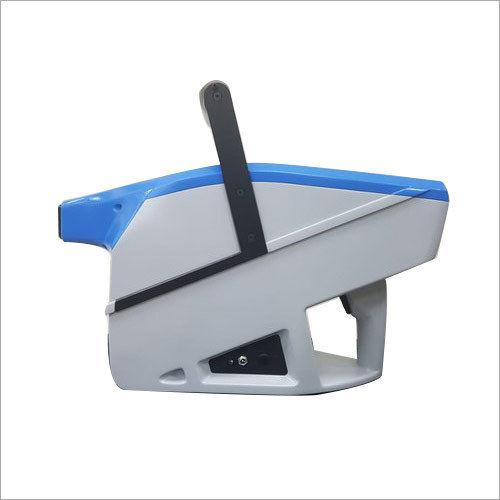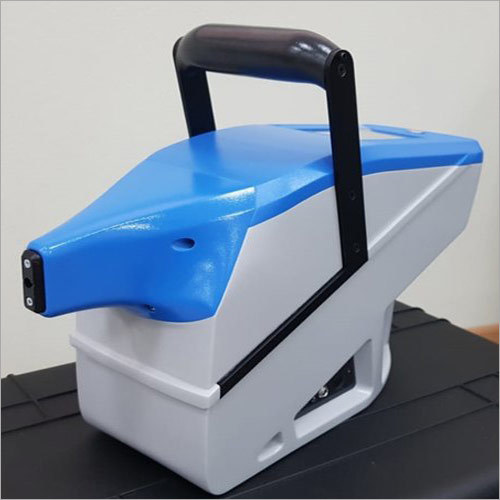X-Ray Fluorescence Spectrometer
10000 INR/Unit
Product Details:
- Material Metal
- Application Industrial
- Power Supply Battery
- Color Blue & White
- Product Type X-Ray Fluorescence Spectrometer
- Click to View more
X
X-Ray Fluorescence Spectrometer Price And Quantity
- 1 Unit
- 10000 INR/Unit
X-Ray Fluorescence Spectrometer Product Specifications
- Industrial
- X-Ray Fluorescence Spectrometer
- Battery
- Metal
- Blue & White
X-Ray Fluorescence Spectrometer Trade Information
- 100 Unit Per Week
- 1 Week
Product Description
X-ray fluorescence spectrometer (XRF) is a powerful analytical technique used for determining the elemental composition of materials. It works based on the principle of measuring the characteristic X-rays emitted by a sample when it is irradiated with high-energy X-rays or gamma rays.
Here's how it typically works:
1. Excitation: The sample is irradiated with X-rays or gamma rays. These high-energy photons cause the atoms in the sample to become excited and emit secondary (fluorescent) X-rays.
2. Fluorescence: When the high-energy photons strike the atoms in the sample, they cause inner shell electrons to be ejected from the atoms. Electrons from outer shells then transition to fill these vacancies, emitting X-ray photons with characteristic energies.
3. Detection: A detector system is used to measure the energy and intensity of the emitted X-rays. Each element emits characteristic X-rays with specific energies, allowing the identification of elements present in the sample.
4. Analysis: The energy and intensity data collected by the detector are analyzed to determine the elemental composition of the sample. This analysis can be qualitative (identifying which elements are present) or quantitative (measuring the concentration of each element).
XRF spectrometers can be either wavelength-dispersive (WDXRF) or energy-dispersive (EDXRF). In WDXRF, the emitted X-rays are diffracted by a crystal, and different elements are separated based on their wavelengths. In EDXRF, the emitted X-rays are dispersed based on their energies using a semiconductor detector.
X-Ray Fluorescence Spectrometer Specifications:
1. Date Transfer: WIFI and Bluetooth
2. Model Name/Number: LIS-01
3. Material: Metal
4. Working Spectral Range: 177-380 nm
5. Source of Radiation: Pulsed DPSS Laser1064 nm
6. Security: Password Protection
7. Power: Replaceable Li-ion Battery
X-Ray Fluorescence Spectrometer Applications:
1. Mining and Exploration: XRF is used for exploration and mining operations to analyze the elemental composition of rocks, ores, and soil samples. It helps in identifying valuable minerals, determining ore grades, and optimizing extraction processes.
2. Environmental Monitoring: XRF is employed in environmental science for analyzing soil, sediment, water, and air samples. It aids in detecting pollutants, monitoring contamination levels, and assessing environmental impact.
3. Metals and Alloys Analysis: XRF is extensively used in metallurgy and materials science for analyzing metals, alloys, and other materials. It helps in quality control, alloy verification, identifying impurities, and determining composition for various industrial applications.
4. Art and Archaeology: XRF is utilized in art conservation and archaeology for studying cultural artifacts, paintings, sculptures, ceramics, and historical objects. It assists in identifying pigments, characterizing materials, and understanding manufacturing techniques.
5. Geological Studies: XRF is valuable in geological research and exploration for analyzing rock samples, core samples, and geological formations. It aids in understanding geological processes, identifying mineral deposits, and studying earth's composition.
6. Forensic Science: XRF is applied in forensic investigations for analyzing trace evidence, gunshot residue, and other materials. It helps in identifying elements present in evidence and providing crucial information for criminal investigations.
7. Pharmaceuticals and Pharmaceuticals: XRF is used in the pharmaceutical industry for quality control, elemental analysis of drug formulations, and detecting trace contaminants in pharmaceutical products.
8. Food and Agriculture: XRF is employed in food safety and agriculture for analyzing soil, plants, food products, and animal feed. It helps in detecting contaminants, assessing nutrient levels, and ensuring compliance with regulatory standards.
9. Construction Materials: XRF is utilized in the construction industry for analyzing cement, concrete, ceramics, and other construction materials. It assists in quality control, identifying components, and monitoring material properties.
10. Consumer Products: XRF is used for analyzing consumer products such as electronics, toys, jewelry, and cosmetics. It helps in detecting hazardous substances, ensuring product safety, and compliance with regulations.
X-Ray Fluorescence Spectrometer FAQ:
Q. What is X-ray fluorescence (XRF) spectroscopy?
Ans: XRF spectroscopy is an analytical technique used to determine the elemental composition of materials by measuring the characteristic X-rays emitted when a sample is irradiated with high-energy X-rays or gamma rays.
Q. How does XRF spectroscopy work?
Ans: XRF works based on the principle of inner-shell ionization. When high-energy photons strike a sample, they cause inner-shell electrons to be ejected, and electrons from higher energy levels transition to fill these vacancies, emitting characteristic X-rays. By detecting and analyzing these emitted X-rays, the elemental composition of the sample can be determined.
Q. What types of samples can be analyzed with XRF?
Ans: XRF can analyze a wide range of sample types, including solids, liquids, powders, and thin films. It is used in various fields such as mining, environmental science, materials science, archaeology, forensics, and industry.
Q. What are the advantages of using XRF spectroscopy?
Ans: XRF offers several advantages, including non-destructive analysis (minimal sample preparation required), rapid analysis times, multi-elemental analysis capability, and the ability to analyze a diverse range of sample types.
Q. What are the different types of XRF spectrometers?
Ans: XRF spectrometers can be classified into two main types: wavelength-dispersive XRF (WDXRF) and energy-dispersive XRF (EDXRF). WDXRF uses diffraction to separate X-rays based on their wavelengths, while EDXRF uses semiconductor detectors to separate X-rays based on their energies.
Q. What is the typical detection limit of XRF spectroscopy?
Ans: The detection limit of XRF spectroscopy depends on various factors, including the elements being analyzed, the instrument's configuration, and sample matrix effects. Generally, detection limits range from parts per million (ppm) to parts per billion (ppb) levels.
Q. Is XRF spectroscopy suitable for quantitative analysis?
Ans: Yes, XRF spectroscopy can be used for both qualitative and quantitative analysis. Quantitative analysis requires calibration using standards of known composition to correlate the intensity of X-ray emissions with the concentration of elements in the sample.
Q. Are there any limitations or considerations when using XRF spectroscopy?
Ans: Some limitations include potential interference from overlapping X-ray emissions, sample heterogeneity affecting measurement accuracy, and limitations in detecting light elements (e.g., hydrogen, helium) and low atomic number elements.
Q. Is sample preparation required for XRF analysis?
Ans: Minimal sample preparation is typically required for solid samples, such as grinding or pressing into pellets. Liquid samples may require dilution or fusion with suitable fluxes. However, sample preparation depends on the specific requirements of the analysis and the nature of the sample.
Q. Are there any safety considerations when using XRF spectrometers?
Ans: XRF spectrometers use X-rays or gamma rays for excitation, so proper radiation safety measures must be followed, including shielding, instrument calibration, and adherence to regulatory guidelines regarding radiation exposure.
Tell us about your requirement

Price:
Quantity
Select Unit
- 50
- 100
- 200
- 250
- 500
- 1000+
Additional detail
Mobile number
Email
 English
English Spanish
Spanish French
French German
German Italian
Italian Chinese (Simplified)
Chinese (Simplified) Japanese
Japanese Korean
Korean Arabic
Arabic Portuguese
Portuguese




 Call Me Free
Call Me Free
